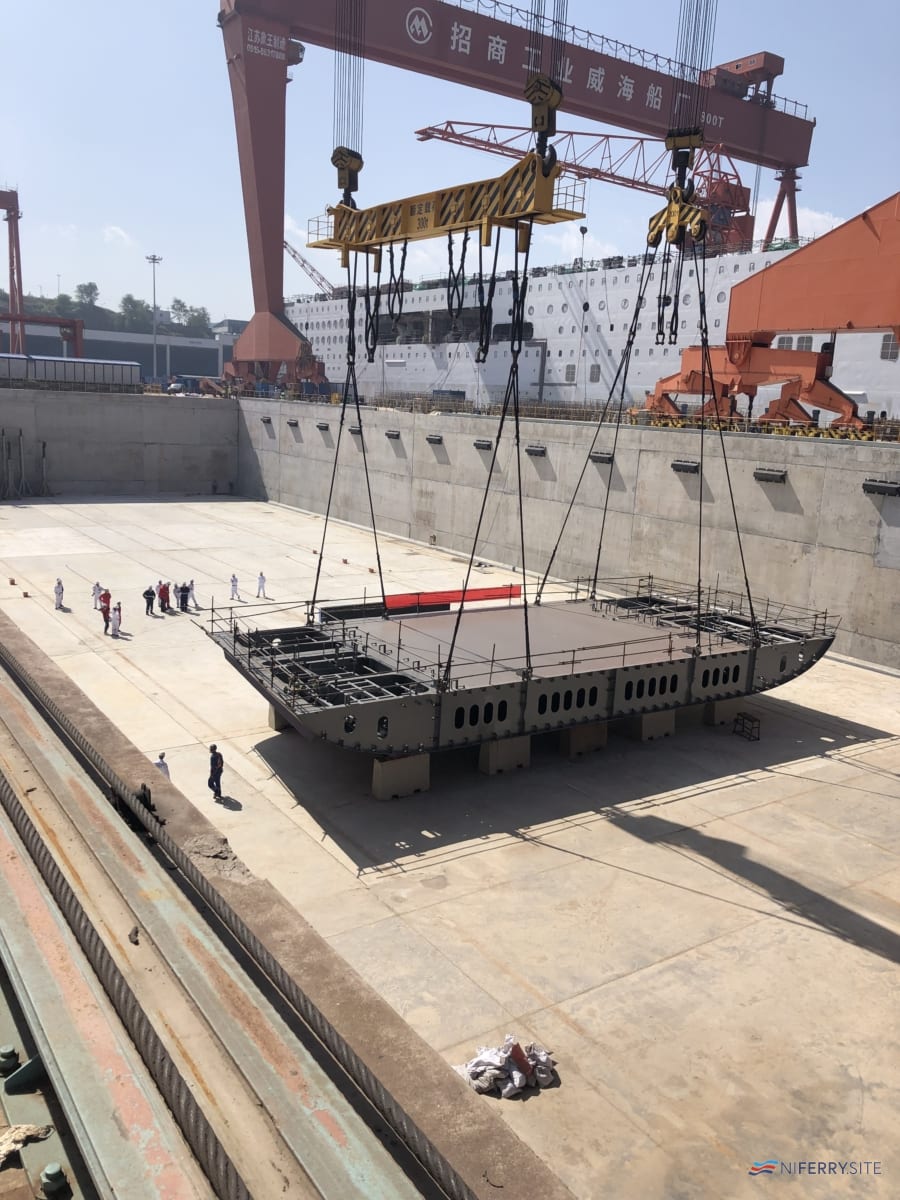The replacement for Brittany Ferries’ Portsmouth to Saint-Malo stalwart BRETAGNE was launched on Saturday October 7. Named SAINT-MALO, the ship is the first of two new hybrid ferries ordered by the company from Stena RoRo.
The investment in the hybrid vessels is part of the largest fleet investment in Brittany Ferries’ 50 year history. Between 2020 and 2025 a total of five new ships will have been delivered to the company, all replacing older, much less environmentally-friendly and efficient vessels.

The keel for SAINT-MALO’s part-sister-ship GUILLAUME DE NORMANDIE was laid on 28 September. The latter ship will replace the NORMANDIE on Brittany Ferries’ busiest route between Caen (Ouistreham) and Portsmouth.

The arrival of the new ships, which are both expected to enter service during early Spring 2025, will replace the two of the oldest members of the Brittany Ferries fleet. BRETAGNE was completed in 1989 and NORMANDIE in 1992.

While SAINT-MALO has been launched, just 75 days have passed since block assembly of the vessel started in Weihai, China. Consequently there is still much work to be done before the ship is delivered around this time next year.

SAINT-MALO and GUILLAUME DE NORMANDIE are based on Stena’s successful E-Flexer platform as are the other ships delivered as part of Brittany Ferries’ current fleet renewal – GALICIA, SALAMANCA, and SANTOÑA. The latest pair will be different from the other Brittany Ferries vessels and will also be the first hybrid vessels delivered to the company.
Environmentally Friendly
Like SALAMANCA and SANTOÑA, SAINT-MALO and GUILLAUME DE NORMANIDE will be fuelled by LNG. Unlike the older ships, however, they will also have 11MWh battery packs installed – the largest of any ferry to date. Combined with the ability to plugin to a shore power connection, once it becomes available, this means that the new ships will be able to manoeuvre and sit alongside in port without emitting any greenhouse gases.
Portsmouth International Port will be first of Brittany Ferries’ ports to offer shore power in 2025. Saint-Malo and Ouistreham will follow in 2027 once development work at the French ports is complete.

Brittany Ferries was recently awarded Green Marine Certified Shipowner accreditation for the fourth year in a row. Last year SALAMANCA and SANTOÑA began using a new LNG bunkering facility at Bilbao in Spain. The use of LNG as fuel in the already more efficient vessels has led to a significant reduction in nitrogen oxide emissions as well as reduced sulphur oxide and particulate emissions. Last November SALAMANCA, which was already the first large LNG-fuelled ferry in service in the UK, became the first large LNG-fuelled ferry in service to Ireland after taking over the Rosslare to Bilbao route from GALICIA.
The replacement of ships which use technology that is over 30 years old with LNG-hybrid vessels will significantly further reduce Brittany Ferries’ fleet emissions.
Bespoke
SAINT-MALO will be the most changed vessel from the standard E-Flexer platform yet, having been heavily customised to Brittany Ferries requirements. The new Saint-Malo to Portsmouth vessel will have an entire additional passenger deck compared to the other vessels in the E-Flexer class.

The additional deck will mean SAINT-MALO will offer more cabins than any other vessel in the E-Flexer class to-date with 386 available. However, this comes at the expense of freight capacity as the additional deck occupies the upper portion of the deck 5 vehicle space (deck 6). Instead, deck 5 will be dedicated to cars and passenger vans – a characteristic that also reflects the passenger heavy mix of traffic on the Saint-Malo route.

The SAINT-MALO and GUILLAUME DE NORMANDIE are also built to a length of 194.7m, fitting the constraints at the harbour at Saint-Malo, but much shorter than the 214.5m of Brittany Ferries other E-Flexer vessels. BRETAGNE and NORMANDIE are significantly shorter than the new ships at 151.2m and 161.4m long respectively but of similar breadth.
Brittany Ferries LNG E-Flexer comparison
| Salamanca / Santona | Saint-Malo | Guillaume de Normandie | |
| Passengers | 1,015 | 1,290 | 1,310 |
| Cabins | 340 | 386 | 220 |
| Freight units | 2,758 lane metres | Up to 63 (approx. 1,100 lm) | Up to 120 (approx, 2,100 lm) |
| Propulsion | LNG mechanical | LNG electric hybrid (11 MWh battery pack) | LNG electric hybrid (11 MWh battery pack) |
| Engines | 2 x 13,740 kW Wärtsilä 12V46DF dual-fuel engines | 2 x 13,740 kW dual-fuel engines (Wärtsilä) | 2 x 13,740 kW dual-fuel engines (Wärtsilä) |
| Delivery | 2022 / 2023 | 2024 | Early-2025 |
| In Service | March 2022 / March 2023 | Spring 2025 | Spring 2025 |
